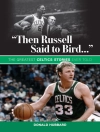Voices of the Game
Curt Smith is “…the voice of authority on baseball broadcasting.” — USA Today
#1 New Release in Photography, Baseball Statistics, Photo Essays, and Photojournalism
In this second in a series of Baseball Hall of Fame books, celebrate the larger-than-life role played by radio and TV baseball announcers in enhancing the pleasure of our national pastime.
Commemorate the 100th anniversary of baseball broadcasting. The first baseball game ever broadcast on radio was on August 5, 1921 by Harold Wampler Arlin, a part-time baseball announcer on Pittsburgh’s KDKA, America’s first commercially licensed radio station. The Pirates defeated the Phillies 8-5.
An insider’s view of baseball. Now you can own Memories from the Microphone and experience baseball from author Curt Smith. He has spent much of his life covering baseball radio and TV, and previously authored baseball books including the classic Voices of The Game.
Relive baseball’s storied past through the eyes of famed baseball announcers. Organized chronologically, Memories from the Microphone charts the history of baseball broadcasting. Enjoy celebrated stories and personalities that have shaped the game—from Mel Allen to Harry Caray, Vin Scully to Joe Morgan, Ernie Harwell to Red Barber.
Also discover:
- Images from the Baseball Hall of Fame’s matchless archive
- Anecdotes and quotes from Curt Smith’s original research
- Interviews with broadcast greats
- Little-known stories, such as Ronald Reagan calling games for WHO Des Moines in the 1930s
- Accounts of diversity in baseball broadcasting, including the TV coverage of Joe Morgan and earlier Hispanic pioneers Buck Canel and Rafael (Felo) Ramirez
- A special section devoted to the Ford C. Frick Award and inductees since its inception in 1978
Also take a nostalgic trip down baseball’s memory lane with other Baseball Hall of Fame books: Picturing America’s Pastime, So You Think You Know Baseball, and Baseball Memories and Dreams.
قائمة المحتويات
Table of Contents
List of Illustrations
Acknowledgements
Foreword
Prologue: ‘Present at the Creation” (Introduction: 1921 First Radio Game)
Chapter 1: “The Pioneers” (1920s: Those Who Began the Craft)
Chapter 2: “Both Sides Now” (1930s: To Broadcast or Not)
Chapter 3: “An Accent on Sound” (1940s: The Migration North)
Chapter 4: “That Old Feeling” (Early 1950s: The Wireless Goes Network)
Chapter 5: “Legend In Your Own Time” (1950s: Local Television’s Sunrise)
Chapter 6: “Millennium in the Morn” (1950s-’60s: Network TV’s Debut)
Chapter 7: “Light in the Midnight Door” (1960s-’70s: Shining Booths Amid the Night)
Chapter 8: “I Sing the Songs” (1960s-’80s: Network TV/Radio Blooms)
Chapter 9: “Across the Rubicon” (1970s-’90s: Cable and Company)
Chapter 10: “We Shall Overcome” (1960-Present: Minority Voices)
Chapter 11: “Technology Meets the Sandlot Kid” (2000-Present: New Voices and Devices”)
Chapter 12: “Postlogue: A Sonnet Read Upon the Heart”
Chapter 13: “The Sound of Cooperstown” (Frick Award History)
Bibliography
Index
About the Author
عن المؤلف
Known as “The Human Vacuum Cleaner, ” Brooks Robinson is regarded as arguably the best defensive third baseman the game has ever seen. Robinson began his career with the Baltimore Orioles – the only team he ever played for – in 1955, and for 23 years dazzled fans on the field with his glove. Off the field, he was humble and gracious. Robinson retired after the 1977 season and the Orioles wasted no time in retiring his No. 5. He led all AL third basemen in fielding percentage 11 times and assists eight times. His 2, 870 games at third base rank No. 1 on the all-time list.He was so beloved in Baltimore that sports writer Gordon Beard wrote: “Brooks (Robinson) never asked anyone to name a candy bar after him. In Baltimore, people named their children after him.” Robinson was elected to the National Baseball Hall of Fame in 1983.












